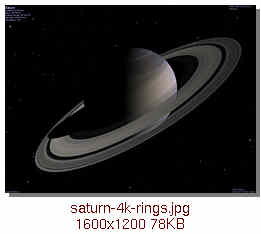


Due to a combination of its lower density, rapid rotation, and fluid state, Saturn is an oblate spheroid; that is, it is flattened at the poles and bulges at the equator. Its equatorial and polar radii differ by almost 10%— 60268 km vs. 54364 km.[3] The other gas planets are also oblate, but to a lesser extent. Saturn is the only planet of the Solar System that is less dense than water. Although Saturn's core is considerably denser than water, the average specific density of the planet is 0.69 g/cm³ due to the gaseous atmosphere. Saturn is only 95 Earth masses,[3] compared to Jupiter, which is 318 times the mass of the Earth[12] but only about 20% larger than Saturn.[13]
The rings were first observed by Galileo Galilei in 1610 with his telescope, but he was unable to identify them as such. He wrote to the Duke of Tuscany that "The planet Saturn is not alone, but is composed of three, which almost touch one another and never move nor change with respect to one another. They are arranged in a line parallel to the zodiac, and the middle one (Saturn itself) is about three times the size of the lateral ones [the edges of the rings]." He also described Saturn as having "ears." In 1612 the plane of the rings was oriented directly at the Earth and the rings appeared to vanish. Mystified, Galileo wondered, "Has Saturn swallowed his children?", referring to the myth of the god Saturn eating his own children to prevent them from overthrowing him.[39] Then, in 1613, they reappeared again, further confusing Galileo.[40]